Analysing the Gothenburg fire: the application of Computational Fire Engineering Tools to Forensic Fire Analysis
The primary purpose of Computational Fire Engineering (CFE) tools such as fire and evacuation models is for fire safety engineering design. However, a growing area of interest is the use of CFE tools for forensic fire analysis and incident investigation. In this application the engineer makes use of CFE to appreciate the events and behavioural actions that led to the outcome associated with an actual incident. In this paper, fire data - generated from small-scale experiments and fire simulation calculations - reflecting an actual incident are used in conjunction with the buildingEXODUS evacuation model in an attempt to forensically analyse an actual fatal fire incident.
When attempting to forensically reproduce an actual incident, great care has to be taken to ensure that the initial and boundary conditions are represented as accurately as possible. However, the process involved in incorporating fire data into the analytical process is complex and subject to many assumptions. In most cases it is extremely difficult to accurately represent these controlling conditions as they unfolded during the actual incident. The precise nature of these conditions is simply not known to the level of detail necessary to allow an accurate computer based reproduction of the actual incident. Thus when using models for forensic analysis it is essential that simulation results are viewed as being indicative rather than absolute. In many cases, computer simulation can only be used to exclude the definitive occurrence of certain events and behaviours rather than determining the occurrence of others.
The case selected for analysis in this project is the Gothenburg Disco incident of 1998. On the evening of October 29 1998, a fire developed in the premises of the Macedonian Association in Gothenburg Sweden. On the evening of the fire, it was estimated that the number of people in the disco reached 400 people. In this incident 63 people died, of which 43 were found ‘piled’ around the internal exit leading to the main stairwell. Fire fighters reported that their access to the hall was blocked by a wall of bodies inside the doorway that reached the top of the doorjamb.
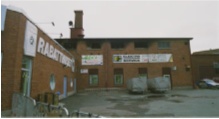 |
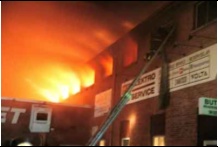 |
| The Hall in Gothenburg | The fire incident |
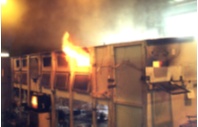 |
 |
| SP scale model of fire in disco hall | View down the main stair |
Figure 1: Scenes from the Gothenburg disco fire.
Information concerning this incident was gathered from several sources, including the fire investigation incident report from National Fire Protection Association (NFPA) and the Swedish National Testing and Research Institute (SP) experimental report, amongst others. Fire hazard data used in the analysis was based on the 1/4 scale fire experiment conducted by SP as part of their analysis of the incident. This data could not be used directly in the evacuation analysis due to the reduced scale of the experiments and because much of the fire specific data required by the evacuation analysis was not collected. In reality, the fire hazard data eventually utilised by the buildingEXODUS forensic analysis did not closely replicate the original incident due to numerous approximations that needed to be performed to convert the data into a useful format (see flowchart below). It should be emphasised therefore that given the process involved in manipulating the fire hazard data that it is only possible to assert that we are modelling a Gothenburg type incident, rather than claiming to represent the actual event accurately. However, this did allow the identification of the broad issues that influenced the outcome of this tragic event. In particular, this enabled the model to be used to examine the hypotheses suggested in the NFPA incident report as well as examining other aspects of the incident.
 |
It is not claimed that the analysis
accurately reproduces the Gothenburg incident, as a key component required
for such a forensic analysis, i.e. the evolution of the fire is not
accurately represented within the evacuation model.
However, bearing this in mind, the model predictions bore a striking resemblance to the events that took place during the actual incident (see figure 2(a)). The model predictions correctly demonstrated that the victims experienced severe congestion during their attempted evacuation. While the model slightly over predicts the number of fatalities, it successfully predicts the fatality order of magnitude. Furthermore, the predicted location of the fatalities matched that found in the actual incident (see figure 2(b)). |
| In addition, the number of injuries predicted in this scenario closely approximated those produced during the actual incident. The analysis therefore provided insight into the tragic event and an understanding of why so many people died at the Gothenburg incident. | |
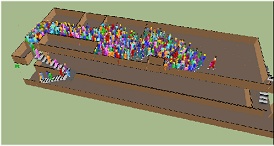 |
 |
| (a) buildingEXODUS representation of congestion around internal exit | (b) Representation of the locations of the fatalities within buildingEXODUS |
Figure 2: Views from the buildingEXODUS reproduction of the disco hall incident.
Given the provisos made in regard to the data supplied, the assumptions made and the procedure outlined, it is contended that the results produced were satisfactory and successfully captured the major events and influences of the original incident. The major conclusion of this work was that the high death toll reported in this incident was a result of the severe level of overcrowding experienced in the hall combined with the loss of one of the means of egress. This analysis has provided insight into this tragic event and an understanding of why so many people died at the Gothenburg incident. The analysis also reveals how the result of this tragic incident could have been avoided, had the number of people within the hall been reduced to the level specified in regulation, or had an additional staircase been provided (see animations below). Clearly, evacuation and fire simulation analysis of this type has an important role to play in fire investigation.
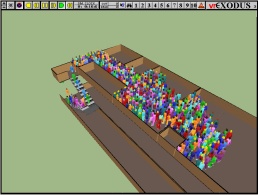 (a) vrEXODUS generated animation of situation with overcrowding and single exit. Real Media (low quality) - [37 sec] (streamed) Real Media (good quality) - [2.15 MB] (downloadable) |
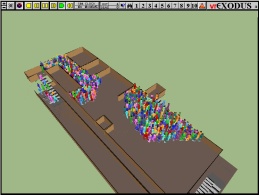 (b) vrEXODUS generated animation of situation with overcrowding and two exits. Real Media (low quality) - [37 sec] (streamed) Real Media (good quality) - [2.01 MB] (downloadable) |
Animations: Animated representation of buildingEXODUS reproduction of the disco hall incident.
Reference:
“The use of Evacuation simulation, Fire Simulation and Experimental Data in Forensic Fire Analysis.”. Jiang, H, Gwynne S., Galea E.R., Lawrence P., Jia F and Ingason H. Proc 2nd Int Pedestrian and Evacuation Dynamics Conference, Ed: E.R.Galea, CMS Press, Greenwich, UK, ISBN 1904521088, pp341-354, 2003.

